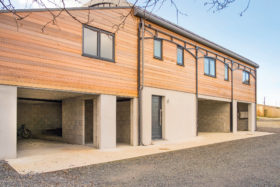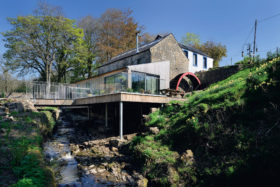
Early Bird Offer! Free tickets to meet independent experts at this summer's Build It Live
Save £24 - Book Now!
Early Bird Offer! Free tickets to meet independent experts at this summer's Build It Live
Save £24 - Book Now!George and Rosie Woods knew that breathing new life into this rundown late-Victorian building – which had previously been converted into flats – was going to be a big challenge. However, they were eager to create an abode that would be warm, sustainable and offer their two children a comfortable, spacious place in which to grow up.
“It was important that we established a bright and roomy home with an extension to increase the existing footprint,” says Rosie. Although the Woods had some clear ideas of their own, they wisely sought the help of an architect and a local estate agent, both of whom advised them on smart ways to improve the existing structure so it would best meet the needs of their young family.
“We followed many of their suggestions, paying particularly close attention to creating an attractive kitchen, bathrooms and a large master bedroom,” says Rosie.
The Woods bought the property in February 2013 and received no objections to the plans their architect had put together. “We got permission fairly quickly, partly because the only aspect of the house that required a drastic change and would affect the street scene was the front elevation, which we wanted to insulate and render,” says George.
“Luckily for us the guidance regarding external wall insulation had changed just a few weeks before we sought permission, and councils were being advised to allow it to be used, provided it was done sensitively.”
Internally, the couple has left one wall with an exposed brick finish, which has been painted white. It runs up through all three storeys of the property as a reminder of its former external appearance.
A significant addition to the property is the much-desired modern extension that houses a new kitchen-diner. The Woods heeded the advice of their professional architect and that of the local planners by opting for a modestly sized enlargement that wouldn’t become a bone of contention with the neighbours.
The addition has transformed the ground floor into a split-level kitchen-diner and living room. “This space was initially quite dark and dingy,” says George. “It was a large room with high ceilings, but the windows were too small so we knew we needed to bring in more sunshine.”
Tall sliding doors lead directly out to a garden that was designed by Rosie. A large picture window in the kitchen helps flood the space with natural illumination. “We rarely need to turn on the lights down here, even on gloomy days it feels bright,” says George.
The couple’s house is positioned on a sloping site. When they took up the floorboards in the living room, they were surprised to discover that there was around six or seven feet of space underneath, spanning the entire footprint of the ground floor.
“We immediately thought it could be used as a small basement,” says Rosie. “When you’re working on a major renovation project you’re never quite sure how things are going to pan out. This area has proved really handy as it provides a hidey-hole for us to squirrel away all of our junk.”
This clever solution has also allowed the Woods to retain tall ceilings in the top-storey zone and create a bright and breezy feel in the guestroom, as it meant that they could avoid devoting the loft space to storage.
Underfloor heating (UFH) has been laid throughout the ground floor, but radiators have been installed elsewhere to help keep the upper-storey bedrooms feeling cosy. “We have suspended beam and block floors, which we insulated before installing the UFH, screed and the covering,” says George.
The house has been packed with plenty of insulation, in the form of rigid Kingspan boards. These have been installed in the ceilings, walls and floors and mean that, once the heating system has reached the desired level, the whole house stays comfortably warm.
The couple also fitted a beautiful Burley stove, which kicks out warmth to complement the UFH system when required. It doubles up as a striking focal point, too, particularly when it’s lit. “I would really recommend one,” says George. “It’s got two or three burning mechanisms; it is really efficient and looks amazing when in use.”
Keen to ensure that their home would have low running costs, George and Rosie sought advice from environmental consultants at Green Tomato Energy and the National Self Build & Renovation Centre (NSBRC) in Swindon.
“We wanted to know about what to spend our money on in order to make the house as thermally efficient as possible,” explains George. “All the experts we spoke to said that it was essential to prioritise the insulation and airtightness. We classed the other elements as non-vital ‘nice to haves’. While it’s great being able to produce your own energy for heating, if the property isn’t sealed properly then there’s not much point.”
Thanks to their thorough research and dedicated approach, the couple estimates their abode is now three times more airtight than a typical modern developer build. “I thoroughly recommend visiting the NSBRC. They were really helpful and we sought their independent advice on a number of occasions,” says George. “The specialists there were able to advise on how to make sure windows were airtight around the frame and around the eaves, too.”
The dwelling also benefits from a mechanical ventilation and heat recovery (MVHR) system, which channels a controlled flow of pre-warmed fresh air into the home, ensuring it remains well-ventilated.
While insulation and airtightness were the key eco improvements, the Woods wanted to make others, too. “We have installed a rainwater harvesting tank under the patio, which is 5,000L in size,” says George. “We only use it for the garden because we have low-flush WCs and showerheads.”
The latter have allowed the couple to save money not only on water, but also on gas bills, as they’re using less energy to heat the domestic hot water supply. “We have not noticed a difference in our showering experience, and we are making really noticeable savings,” says George.
Solar thermal panels from Viridian Solar have also been installed on the roof and help supplement the heating system during the summer. Throughout the sunnier months of the year, this renewable tech fulfils all of the family’s hot water needs.
During the course of the project, George and Rosie discovered that there are endless possibilities when it comes to the realm of artificial illumination schemes. Because the couple were eager to establish a household with low energy consumption, they installed LEDs throughout the dwelling.
Since fitting these units, they’ve been pleased to learn that they cost very little to run. “Having all the downstairs LEDs switched on is the equivalent to burning one 60 watt bulb,” explains George. Many of them have been paired with dimmer switches to create different ambiences as well.
All in all, the couple are delighted with the final result of their extension and renovation. “Our friends recently completed their own refurbishment, but when they came over and saw our place they realised that they wished they’d used an architect too,” says Rosie. “The kids are both really happy running around and there’s loads of space for them – I feel lucky to be living in this wonderful home.”

